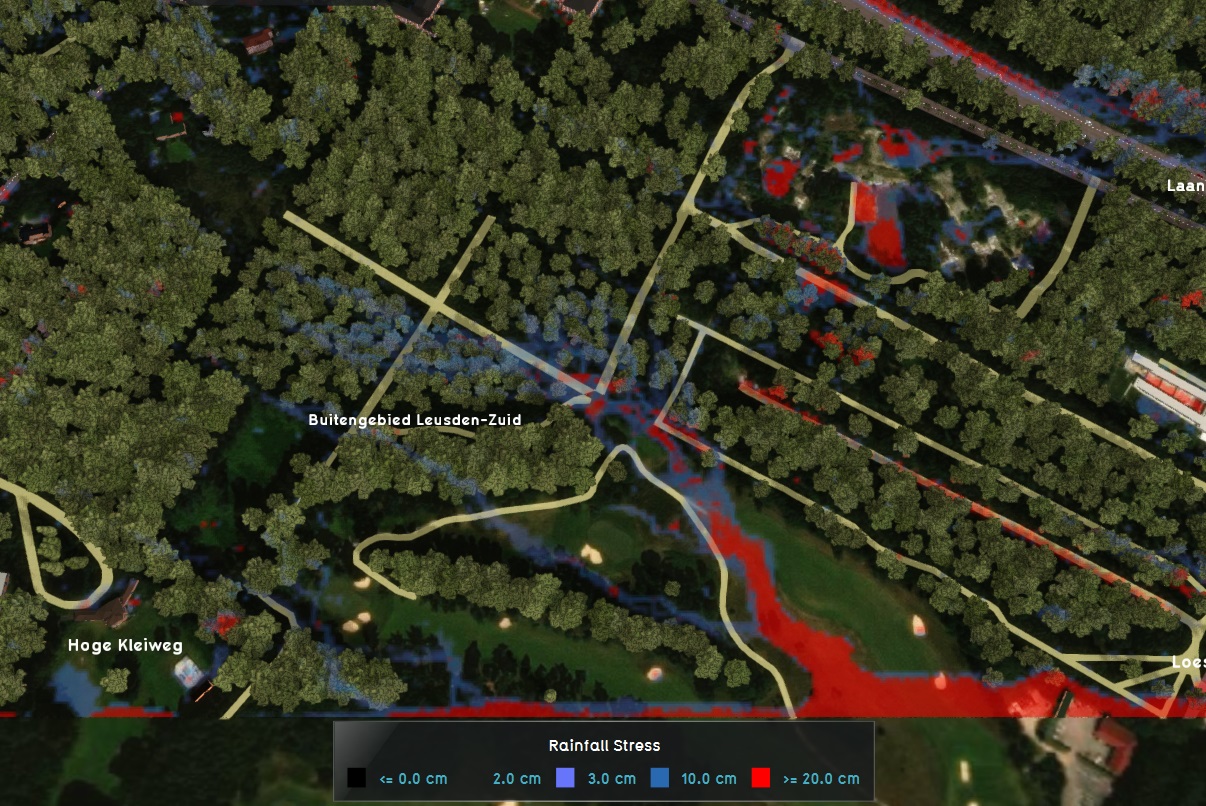Rainfall Overlay
The Rainfall Overlay is an overlay based on the water module calculations, that displays the hazard and impact of heavy rainfall over the project area. Based on the elevation model, terrain roughness and representations of the sewer and water systems, several result types can be displayed.
A Rainfall Overlay Tutorial is available to start working with this overlay.
Rainfall overlay results
Flooding overlay results
List of Result Types
Rainfall overlay calculations
Main article: Rainfall Overlay Calculations (Water overlay)
Calculation Preference
Here you can manipulate the computation time step by choosing between the option SPEED, AVERAGE and ACCURACY. The computational timesteps will be set according to the Courant criterion:
Δt = Δx /umax
where:
- Δt = computational timestep
- Δx = grid cell size
- umax = max velocity, assumed 2.5 (SPEED), 5 (AVERAGE) and 10 (ACCURACY) m&sub3;/s respectively
Grid cell size
The Tygron Platform computes flow equations over a rectangular cartesian grid, the grid cell size can be set in the General Tab of the Rainfall Overlay. Note: if you choose a smaller grid cell size, both the amount of time steps (see Calculation Preference) and amount of computational cells increase.
Export GeoTiff & Water Balance
You can export the current result-type as GeoTiff and a waterbalance as Microsoft Excel file.
Debug Info
General info
The debug info contains the following information:
- Rain: the amount of rainfall (mm) in the duration of the rainfall event (hours)
- Total Simulation: the simulation period (hours)
- Cells: The dimensions of the simulation: the amount of computational cells and the amount of time steps (cycles)
- Weir flow: the amount of water flown over weirs during simulation (m3)
- Sewer overflow: the amount of water flown over sewer overflows during simulation (m3)
- GPU time: the computation time on GPU (seconds)
- Max Courant avg: the maximum courant numbers reached during the simulation
Water balance
The water balance is made up of the following components:
- Land surface: amount of water on the land surface after simulation (m3)
- Water surface: amount of water stored on water cells after simulation (m3)
- Building storage: amount of water stored in building storage (m3)
- Sewer storage: amount of water stored in sewers after simulation (m3)
- Underground storage: amount of water stored in the sub-soil after simulation (m3)
- Evaporated: amount of water evaporated after simulation (m3)
- Outlet: amount of water extracted from the model during the simulation via outlets of water areas or sewer pumps (m3).
Overlay Keys
Keys referring to area attributes
| Attribute | Unit | Description |
|---|---|---|
| Water Level | m + datum | initial water level, relative to datum, for all water cells in a water area |
| Outlet | m3/s | water abstraction for all water cells in a water area |
| Sewer Storage | m | available storage in sewers at the start of simulation in a sewer area |
| Sewer Pump Speed | m3/s | sewer water abstraction for all cells in a sewer area |
Keys referring to structures (building attributes)
| Attribute | Unit | Description |
|---|---|---|
| Weir Height | m + datum | weir crest level |
| Weir Width | m | the width of the crest of a weir |
| Weir Coefficient | linear weir coefficient for accounting discharge & contraction losses | |
| Culvert Speed | m3/s | the discharge capacity of a culvert |
| Pump Speed | m3/s | the capacity of a pump |
| Sewer Overflow Height | m + datum | the height of a crest of a sewer overflow |
| Sewer Overflow Speed | m3/s | the discharge capacity of a sewer overflow |
Overlay Attributes
| Attribute | Unit | Description |
|---|---|---|
| ALLOWED_WATER_INCREASE_M | m | increment by which the water level on a water cell is allowed to increase before the depth is shown in the water stress result type |
| IMPACT FLOOD_THRESHOLD_M | m | maximum waterdepth around a building where after the building is assumed impacted |
| MIN_SLOPE | slope whereunder the pressure slope is assumed 0 | |
| SEWER_OVERFLOW_THRESHOLD | fraction of storage whereafter sewer overflows take place | |
| SIMULATION_TIME_HOURS | hours | simulation time |
References
- STOWA (2017) ∙ Benchmark Inundatiemodellen, Modelfunctionaliteiten en testbankberekeningen ∙ found at: https://ruimtelijkeadaptatie.nl/publish/pages/129612/benchmark_inundatiemodellen_stowa_2017.pdf (last visited 2018-08-13)
How-to's
